Submitted:
17 April 2023
Posted:
18 April 2023
You are already at the latest version
Abstract
Keywords:
1. Introduction
2. Materials and methods
2.1. Study area and data
2.2. Methods
2.2.1. Standardized precipitation evapotranspiration index
2.2.2. Partial least squares regression
3. Results
3.1. Phenological variation characteristics of S. krylovii
3.2. Response of phenological periods to drought at different time scales
3.3. Drought time scale affecting the phenological period
4. Discussion
5. Conclusions
Author Contributions
Funding
Institutional Review Board Statement
Informed Consent Statement
Data Availability Statement
Acknowledgments
Conflicts of Interest
References
- Luo, M.; Meng, F.H.; Sa, C.L.; Duan, Y.C.; Bao, Y.; Liu, T.; De Maeyer, P. Response of vegetation phenology to soil moisture dynamics in the Mongolian Plateau. Catena 2021, 206, 105505. [Google Scholar] [CrossRef]
- Richardson, A.D.; Keenan, T.F.; Migliavacca, M.; Ryu, Y.; Sonnentag, O.; Toomey, M. Climate change, phenology, and phenological control of vegetation feedbacks to the climate system. Agricultural and Forest Meteorology 2013, 169, 156–173. [Google Scholar] [CrossRef]
- Wang, M.; Li, P.; Peng, C.H.; Xiao, J.F.; Zhou, X.L.; Luo, Y.P.; Zhang, C.C. Divergent responses of autumn vegetation phenology to climate extremes over northern middle and high latitudes. Global Ecology and Biogeography 2022, 31, 2281–2296. [Google Scholar] [CrossRef]
- Dai, A.G. Increasing drought under global warming in observations and models. Nature Climate Change 2012, 3, 52–58. [Google Scholar] [CrossRef]
- Zhou, G.S. Research prospect on impact of climate change on agricultural production in China. Meteorological and Environmental Sciences 2015, 38, 80–94. [Google Scholar]
- Wang, P.C.; Huang, M.T.; Zhai, P.M. New progress and enlightenment on different types of drought changes from IPCC Sixth Assessment Report. Acta Meteorologica Sinica 2022, 80, 168–175. [Google Scholar]
- Ma, X.L.; Huete, A.; Moran, S.; Ponce-Campos, G.; Eamus, D. Abrupt shifts in phenology and vegetation productivity under climate extremes. Journal of Geophysical Research: Biogeosciences 2015, 120, 2036–2052. [Google Scholar] [CrossRef]
- Jentsch, A.; Kreyling, J.; Boettcher-Treschkow, J.; Beierkuhnlein, C. Beyond gradual warming: extreme weather events alter flower phenology of European grassland and heath species. Global Change Biology 2009, 15, 837–849. [Google Scholar] [CrossRef]
- Huang, W.L.; Zhang, Q.; Kong, D.D.; Gu, X.H.; Sun, P.; Hu, P. Response of vegetation phenology to drought in Inner Mongolia from 1982 to 2013. Acta Ecologica Sinica 2019, 39, 4953–4965. [Google Scholar]
- Zeng, Z.Q.; Wu, W.X.; Ge, Q.S.; Li, Z.l.; Wang, X.Y.; Zhou, Y.; Zhang, Z.T.; Li, Y.M.; Huang, H.; Liu, G.X.; et al. Legacy effects of spring phenology on vegetation growth under preseason meteorological drought in the Northern Hemisphere. Agricultural and Forest Meteorology 2021, 310, 108630. [Google Scholar] [CrossRef]
- Li, C.L.; Filho, W.L.; Yin, J.; Hu, R.C.; Wang, J.; Yang, C.S.; Yin, S.; Bao, Y.H.; Ayal, D.Y. Assessing vegetation response to multi-time-scale drought across inner Mongolia plateau. Journal of Cleaner Production 2018, 179, 210–216. [Google Scholar] [CrossRef]
- Hua, T.; Wang, X.M.; Zhang, C.; Lang, L.L.; Li, H. Responses of vegetation activity to drought in Northern China. Land Degradation Development 2017, 28, 1913–1921. [Google Scholar] [CrossRef]
- Nogueira, C.; Bugalho, M.N.; Pereira, J.S.; Caldeira, M.C. Extended autumn drought, but not nitrogen deposition, affects the diversity and productivity of a Mediterranean grassland. Environmental and Experimental Botany 2017, 138, 99–108. [Google Scholar] [CrossRef]
- Kang, W.P.; Wang, T.; Liu, S.L. The response of vegetation phenology and productivity to drought in semi-arid regions of Northern China. Remote Sensing 2018, 10, 727. [Google Scholar] [CrossRef]
- Ge, W.Y.; Han, J.Q.; Zhang, D.J.; Wang, F. Divergent impacts of droughts on vegetation phenology and productivity in the Yungui Plateau, southwest China. Ecological Indicators 2021, 127, 107743. [Google Scholar] [CrossRef]
- Wu, C.Y.; Peng, J.; Ciais, P.; Peñuelas, J.; Wang, H.J.; Beguería, S.; Andrew Black, T.; Jassal, R.S.; Zhang, X.Y.; Yuan, W.P.; et al. Increased drought effects on the phenology of autumn leaf senescence. Nature Climate Change 2022, 12, 943–949. [Google Scholar] [CrossRef]
- Cui, T.F.; Martz, L.; Guo, X.L. Grassland phenology response to drought in the Canadian Prairies. Remote Sensing 2017, 9, 1258. [Google Scholar] [CrossRef]
- Yuan, M.X.; Zhao, L.; Lin, A.W.; Wang, L.C.; Li, Q.J.; She, D.X.; Qu, S. Impacts of preseason drought on vegetation spring phenology across the Northeast China Transect. Science of The Total Environment 2020, 738, 140297. [Google Scholar] [CrossRef]
- Lai, P.Y.; Zhang, M.; Ge, Z.X.; Hao, B.F.; Song, Z.J.; Huang, J.; Ma, M.G.; Yang, H.; Han, X.J. Responses of seasonal indicators to extreme droughts in Southwest China. Remote Sensing 2020, 12, 818. [Google Scholar] [CrossRef]
- Ivits, E.; Horion, S.; Fensholt, R.; Cherlet, M. Drought footprint on European ecosystems between 1999 and 2010 assessed by remotely sensed vegetation phenology and productivity. Global Change Biology 2014, 20, 581–593. [Google Scholar] [CrossRef]
- Peng, J.; Wu, C.Y.; Zhang, X.Y.; Wang, X.Y.; Gonsamo, A. Satellite detection of cumulative and lagged effects of drought on autumn leaf senescence over the Northern Hemisphere. Global Change Biology 2019, 25, 2174–2188. [Google Scholar] [CrossRef] [PubMed]
- Beguería, S.; Vicente-Serrano, S.M.; Reig, F.; Latorre, B. Standardized precipitation evapotranspiration index (SPEI) revisited: parameter fitting, evapotranspiration models, tools, datasets and drought monitoring. International Journal of Climatology 2014, 34, 3001–3023. [Google Scholar] [CrossRef]
- Vicente-Serrano, S.M.; Beguería, S.; López-Moreno, J.I. A multiscalar drought index sensitive to global warming: the Standardized Precipitation Evapotranspiration Index. Journal of Climate 2010, 23, 1696–1718. [Google Scholar] [CrossRef]
- Huang, J.L.; Zhai, J.Q.; Jiang, T.; Wang, Y.J.; Li, X.C.; Wang, R.; Xiong, M.; Su, B.; Fischer, T. Analysis of future drought characteristics in China using the regional climate model CCLM. Climate Dynamics 2017, 50, 507–525. [Google Scholar] [CrossRef]
- Lyu, D.; Bao, G.; Tong, S.Q.; Lei, J. Response of phenological vegetation wilting period to multi-scale drying-wetting changes in Xilingol. China Environment Science 2022, 42, 323–335. [Google Scholar]
- Li, J.L.; Wu, C.Y.; Wang, X.Y.; Peng, J.; Dong, D.L.; Lin, G.; Gonsamo, A. Satellite observed indicators of the maximum plant growth potential and their responses to drought over Tibetan Plateau (1982–2015). Ecological Indicators 2020, 108, 105732. [Google Scholar] [CrossRef]
- Deng, H.Y.; Yin, Y.H.; Wu, S.H.; Xu, X.F. Contrasting drought impacts on the start of phenological growing season in Northern China during 1982–2015. International Journal of Climatology 2019, 40, 3330–3347. [Google Scholar] [CrossRef]
- Wan, M.W.; Liu, X.Z. Methods of phenological observation in China; Science and Technology Press: Beijing, China, 1979. [Google Scholar]
- Shi, G.H. Phenological variation of main herbages during the last 20 years in the typical steppe of Inner Mongolia Plateau China. Chinese Journal of Grassland 2019, 41, 80–88. [Google Scholar]
- Luedeling, E.; Gassner, A. Partial Least Squares Regression for analyzing walnut phenology in California. Agricultural and Forest Meteorology 2012, 158–159, 43–52. [Google Scholar] [CrossRef]
- Liu, E.H.; Zhou, G.S.; He, Q.J.; Wu, B.Y.; Zhou, H.L.; Gu, W.J. Climatic mechanism of delaying the start and advancing the end of the growing season of Stipa krylovii in a semi-arid region from 1985–2018. Agronomy 2022, 12, 1906. [Google Scholar] [CrossRef]
- Guo, L.; Dai, J.H.; Ranjitkar, S.; Xu, J.C.; Luedeling, E. Response of chestnut phenology in China to climate variation and change. Agricultural and Forest Meteorology 2013, 180, 164–172. [Google Scholar] [CrossRef]
- Pak, D.; Biddinger, D.; Bjørnstad, O.N. Local and regional climate variables driving spring phenology of tortricid pests: a 36 year study. Ecological Entomology 2018, 44, 367–379. [Google Scholar] [CrossRef]
- Li, X.T.; Guo, W.; Chen, J.; Ni, X.N.; Wei, X.Y. Responses of vegetation green-up date to temperature variation in alpine grassland on the Tibetan Plateau. Ecological Indicators 2019, 104, 390–397. [Google Scholar] [CrossRef]
- Yin, C.; Yang, Y.P.; Yang, F.; Chen, X.N.; Xin, Y.; Luo, P.X. Diagnose the dominant climate factors and periods of spring phenology in Qinling Mountains, China. Ecological Indicators 2021, 131, 108211. [Google Scholar] [CrossRef]
- Xin, Q.C.; Broich, M.; Zhu, P.; Gong, P. Modeling grassland spring onset across the Western United States using climate variables and MODIS-derived phenology metrics. Remote Sensing of Environment 2015, 161, 63–77. [Google Scholar] [CrossRef]
- Ganjurjav, H.; Gornish, E.S.; Hu, G.Z.; Schwartz, M.W.; Wan, Y.F.; Li, Y.; Gao, Q.Z. Warming and precipitation addition interact to affect plant spring phenology in alpine meadows on the central Qinghai-Tibetan Plateau. Agricultural and Forest Meteorology 2020, 287, 107943. [Google Scholar] [CrossRef]
- Ji, Z.X.; Hou, Q.Q.; Fei, T.T.; Chen, Y.; Xie, B.P.; Wu, H.W. Sensitive response of vegetation phenology to seasonal drought in the Loess Plateau. Arid Land Geography 2022, 45, 557–565. [Google Scholar]
- Xu, L.L. Non-linear response of dominant plant species regreening to precipitation in mid-west Inner Mongolia in spring. Acta Ecologica Sinica 2020, 40, 9120–9128. [Google Scholar]
- Shi, G.H.; Ji, X.L.; Chen, S.H. Effects of climate change on phenophase and yield of Cleistogenes squarrosa in Xilingguole typical grassland. Chinese Journal of Grassland 2017, 39, 42–49. [Google Scholar]
- Xiao, F.; Sang, J.; Wang, H.M. Effects of cliamte change on typical grassland plant phenology in Ewenki, Inner Mongolia. Acta Ecologica Sinica 2020, 40, 2784–2792. [Google Scholar]
- Zhang, F. , Zhou, G.S., Wang, Y.H. Phenological calendar of Stipa krylovii steppe in Inner Mongolia, China and its correlation with climatic variables. Journal of Plant Ecology 2008, 32, 1312–1322. [Google Scholar]
- Fan, D.Q.; Zhao, X.S.; Zhu, W.Q.; Sun, W.B.; Qiu, Y. An improved phenology model for monitoring green-up date variation in Leymus chinensis steppe in Inner Mongolia during 1962–2017. Agricultural and Forest Meteorology 2020, 291, 108091. [Google Scholar] [CrossRef]
- He, Z.B.; Du, J.; Chen, L.F.; Zhu, X.; Lin, P.F.; Zhao, M.M.; Fang, S. Impacts of recent climate extremes on spring phenology in arid-mountain ecosystems in China. Agricultural and Forest Meteorology 2018, 260, 31–40. [Google Scholar] [CrossRef]
- Luo, W.R.; Hu, G.Z.; Ganjurjav, H.; Gao, Q.Z.; Li, Y.; Ge, Y.Q.; Li, Y.; He, S.C.; Danjiu, L.B. Effects of simulated drought on plant phenology and productivity in an alpine meadow in Northern Tibet. Acta Prataculturae Sinica 2021, 30, 82–92. [Google Scholar]
- Ji, S.P.; Ren, S.L.; Li, Y.R.; Dong, J.Y.; Wang, L.F.; Quan, Q.; Liu, J. Diverse responses of spring phenology to preseason drought and warming under different biomes in the North China Plain. Science of the Total Environment 2021, 766, 144437. [Google Scholar] [CrossRef]
- Yun, J.; Jeong, S.J.; Ho, C.H.; Park, C.E.; Park, H.; Kim, J. Influence of winter precipitation on spring phenology in boreal forests. Global Change Biology 2018, 24, 5176–5187. [Google Scholar] [CrossRef] [PubMed]
- Bernal, M.; Estiarte, M.; Penuelas, J. Drought advances spring growth phenology of the Mediterranean shrub Erica multiflora. Plant Biology 2011, 13, 252–257. [Google Scholar] [CrossRef]
- Vogel, J. Drivers of phenological changes in southern Europe. International Journal Biometeorology 2022, 66, 1903–1914. [Google Scholar] [CrossRef]
- Yuan, Z.H.; Tong, S.Q.; Bao, G.; Chen, J.Q.; Yin, S.; Li, F.; Sa, C.L.; Bao, Y.H. Spatiotemporal variation of autumn phenology responses to preseason drought and temperature in alpine and temperate grasslands in China. Science of the Total Environment 2022, 859, 160373. [Google Scholar] [CrossRef]
- Ge, C.H.; Sun, S.; Yao, R.; Sun, P.; Li, M.; Bian, Y.J. Long-term vegetation phenology changes and response to multi-scale meteorological drought on the Loess Plateau, China. Journal of Hydrology 2022, 614, 128605. [Google Scholar] [CrossRef]
- Li, P.; Liu, Z.L.; Zhou, X.L.; Xie, B.G.; Li, Z.W.; Luo, Y.P.; Zhu, Q.A.; Peng, C.H. Combined control of multiple extreme climate stressors on autumn vegetation phenology on the Tibetan Plateau under past and future climate change. Agricultural and Forest Meteorology 2021, 308, 108571. [Google Scholar] [CrossRef]
- Xie, Y.Y.; Wang, X.J.; Silander, J.A. Deciduous forest responses to temperature, precipitation, and drought imply complex climate change impacts. Proceedings of the National Academy of Sciences of the United States of America 2015, 112, 13585–13590. [Google Scholar] [CrossRef] [PubMed]
- Li, Q.Y.; Xu, L.; Pan, X.B.; Zhang, L.Z.; Li, C.; Yang, N.; Qi, J.G. Modeling phenological responses of Inner Mongolia grassland species to regional climate change. Environmental Research Letters 2016, 11, 015002. [Google Scholar] [CrossRef]
- Zhang, C.H.; Zhang, Z.L.; Jia, P. Plants flowering phenology in Gannan alpine meadow. Pratacultural Science 2016, 33, 283–289. [Google Scholar]
- Kazan, K.; Lyons, R. The link between flowering time and stress tolerance. Journal of Experimental Botany 2016, 67, 47–60. [Google Scholar] [CrossRef]
- Farooq, M.; Wahid, A.; Kobayashi, N.; Fujita, D.; Basra, S.M.A. Plant drought stress: effects, mechanisms and management. Agronomy for Sustainable Development 2009, 29, 185–212. [Google Scholar] [CrossRef]
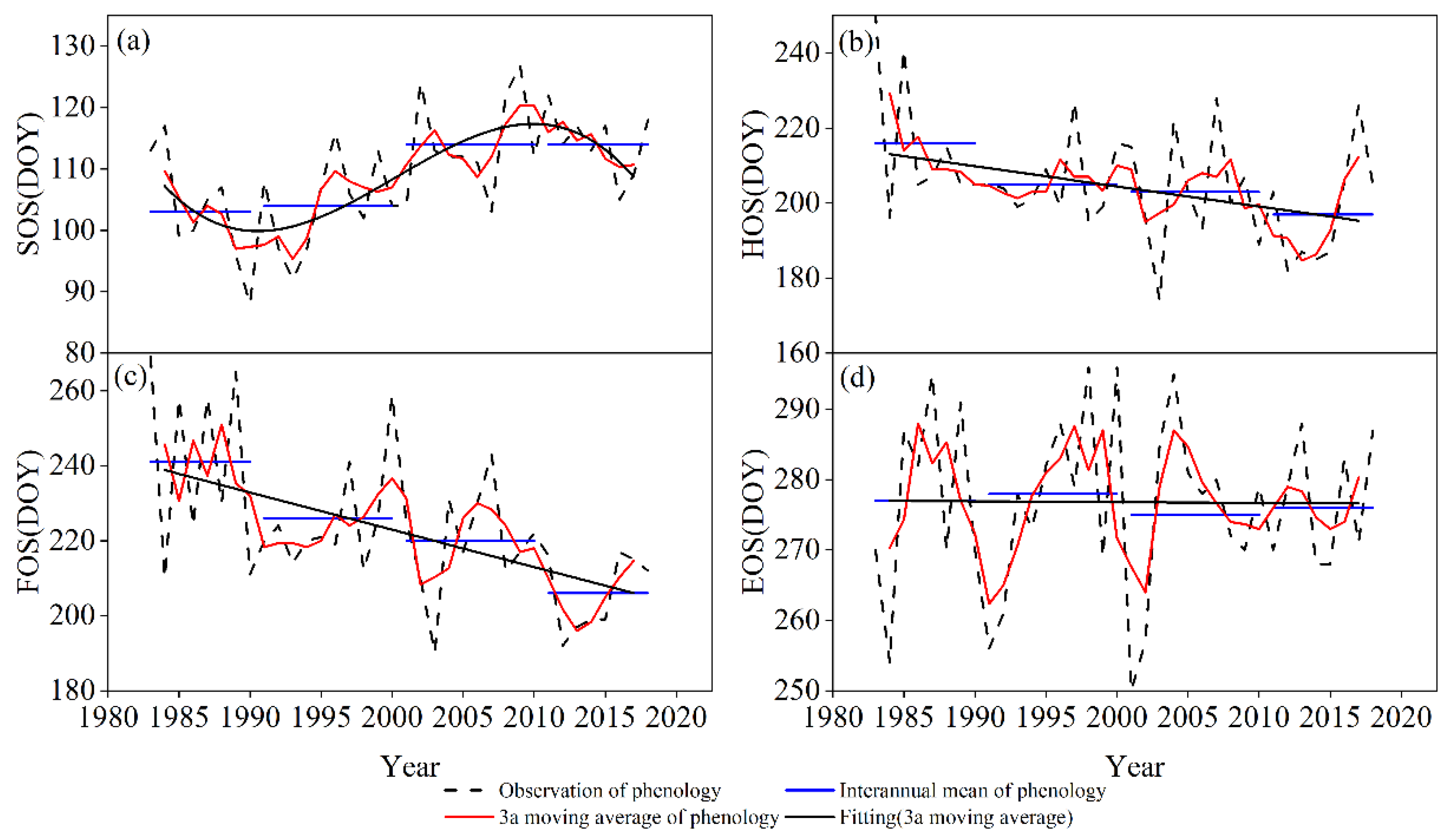

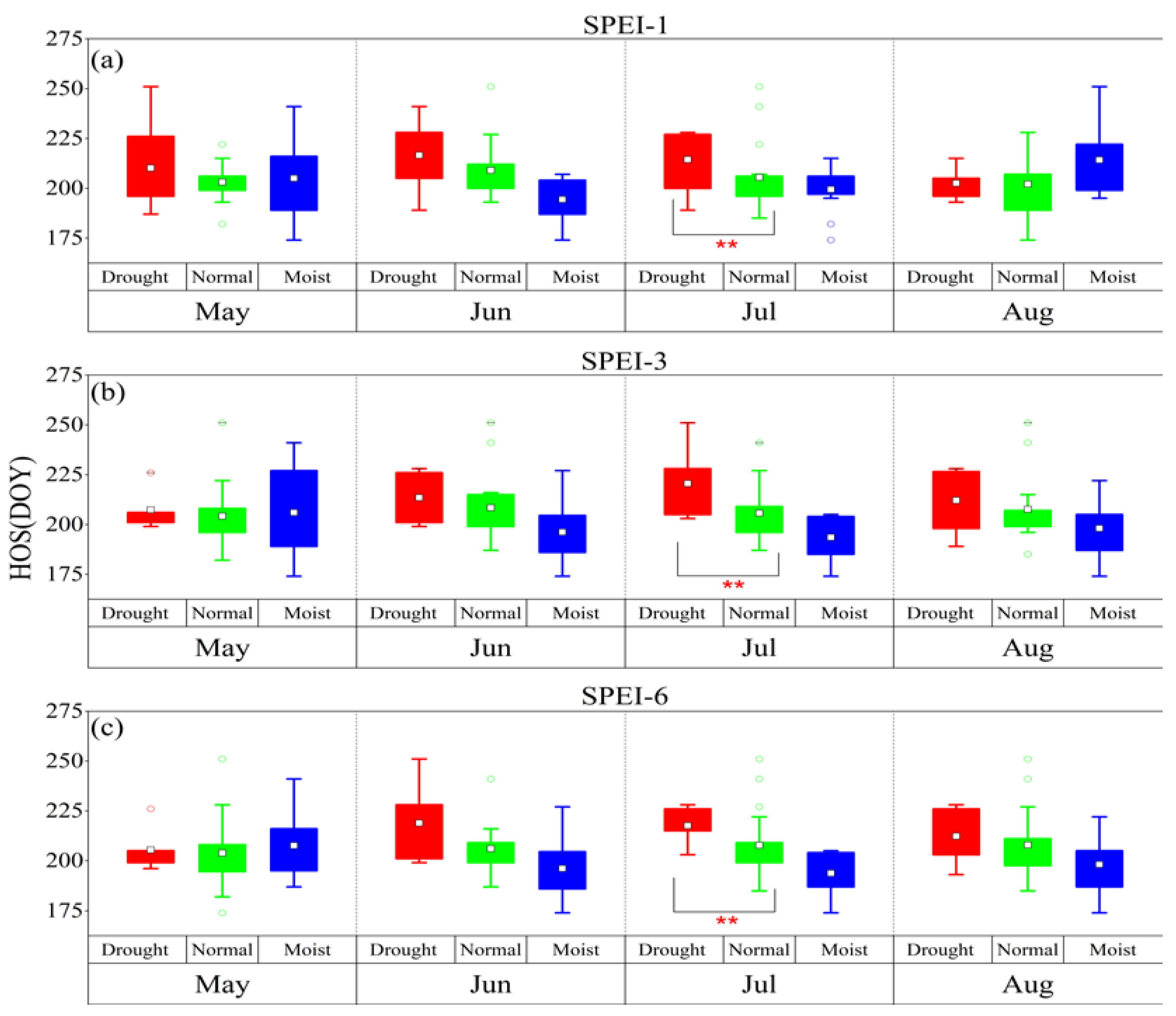



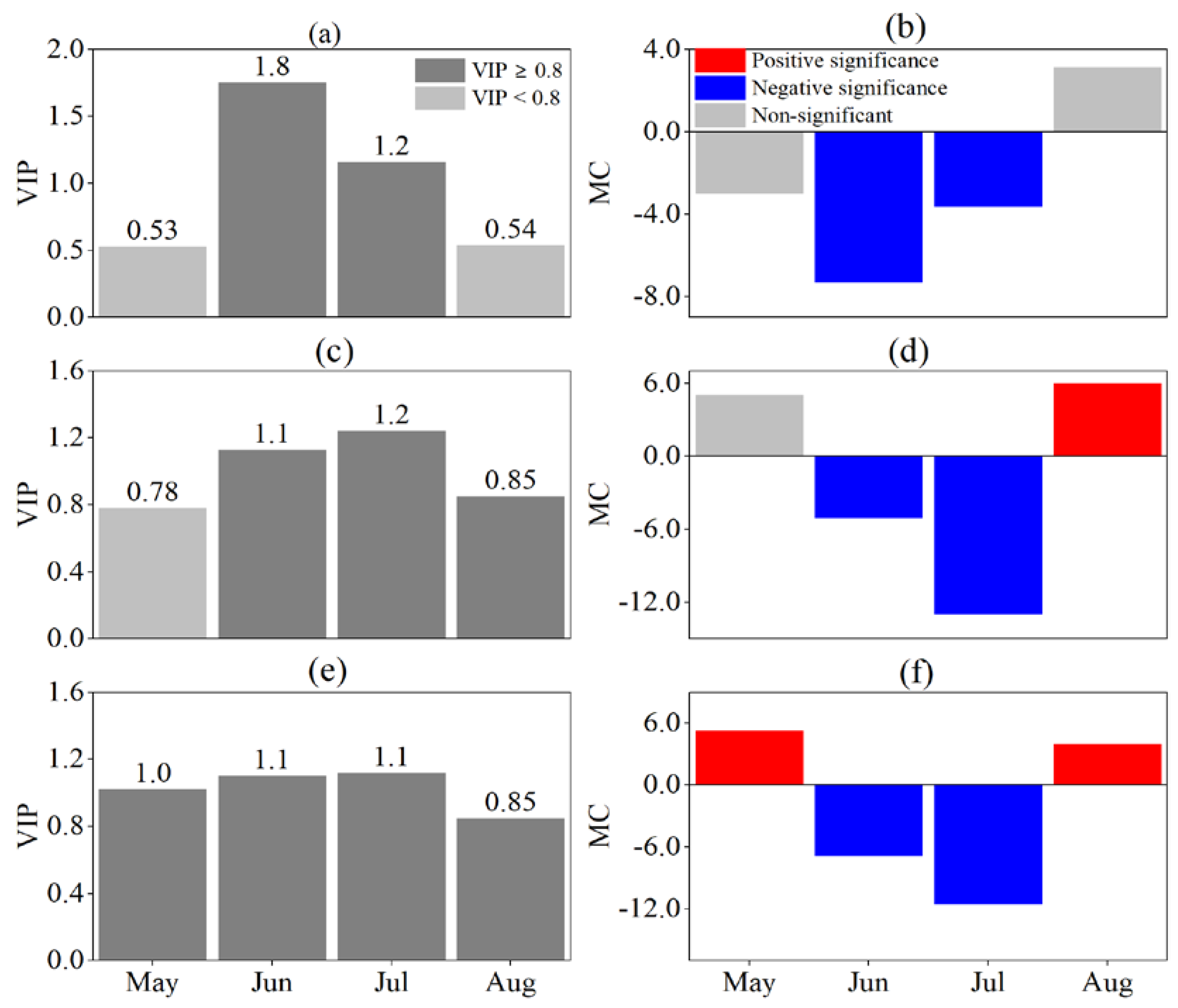
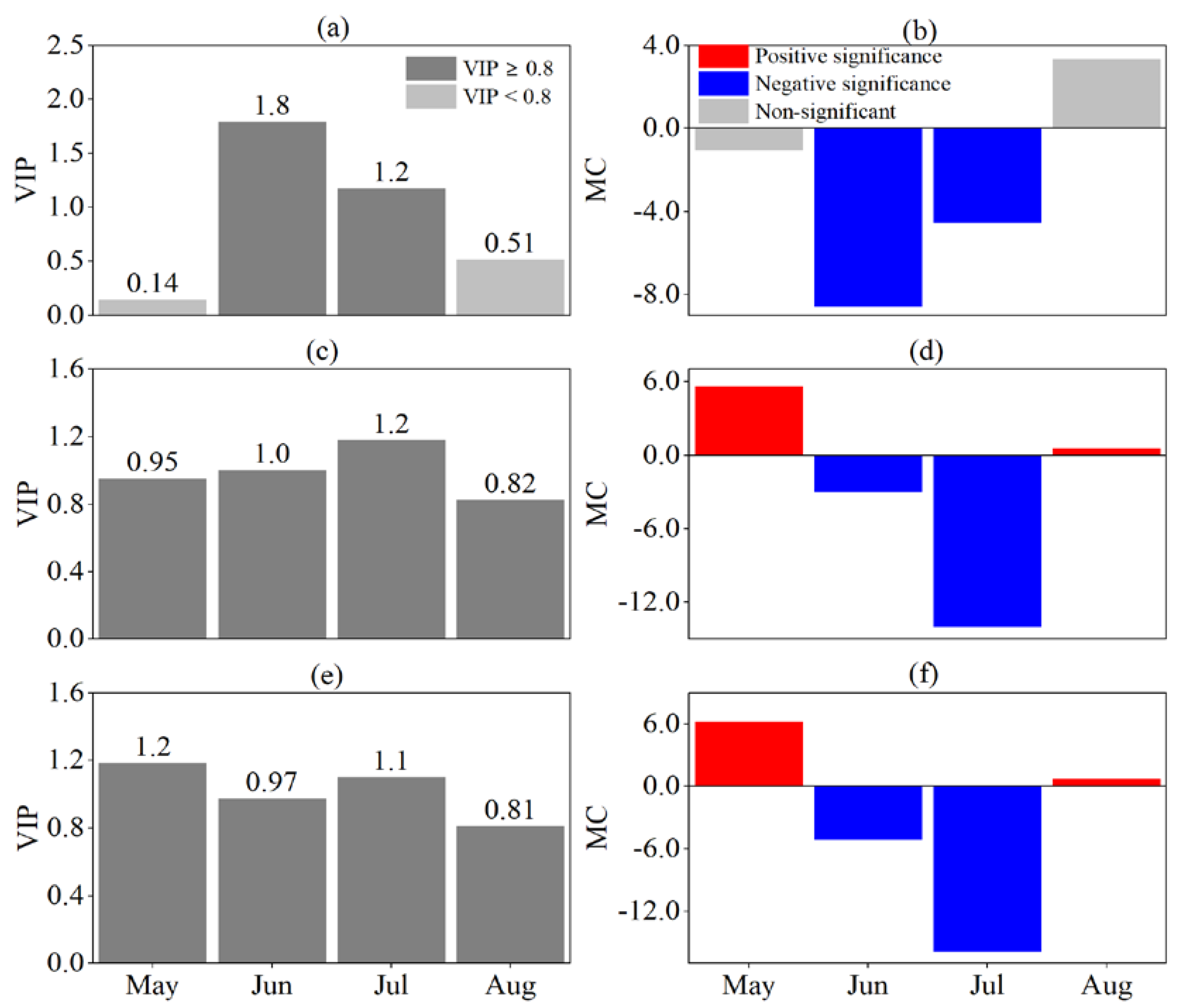
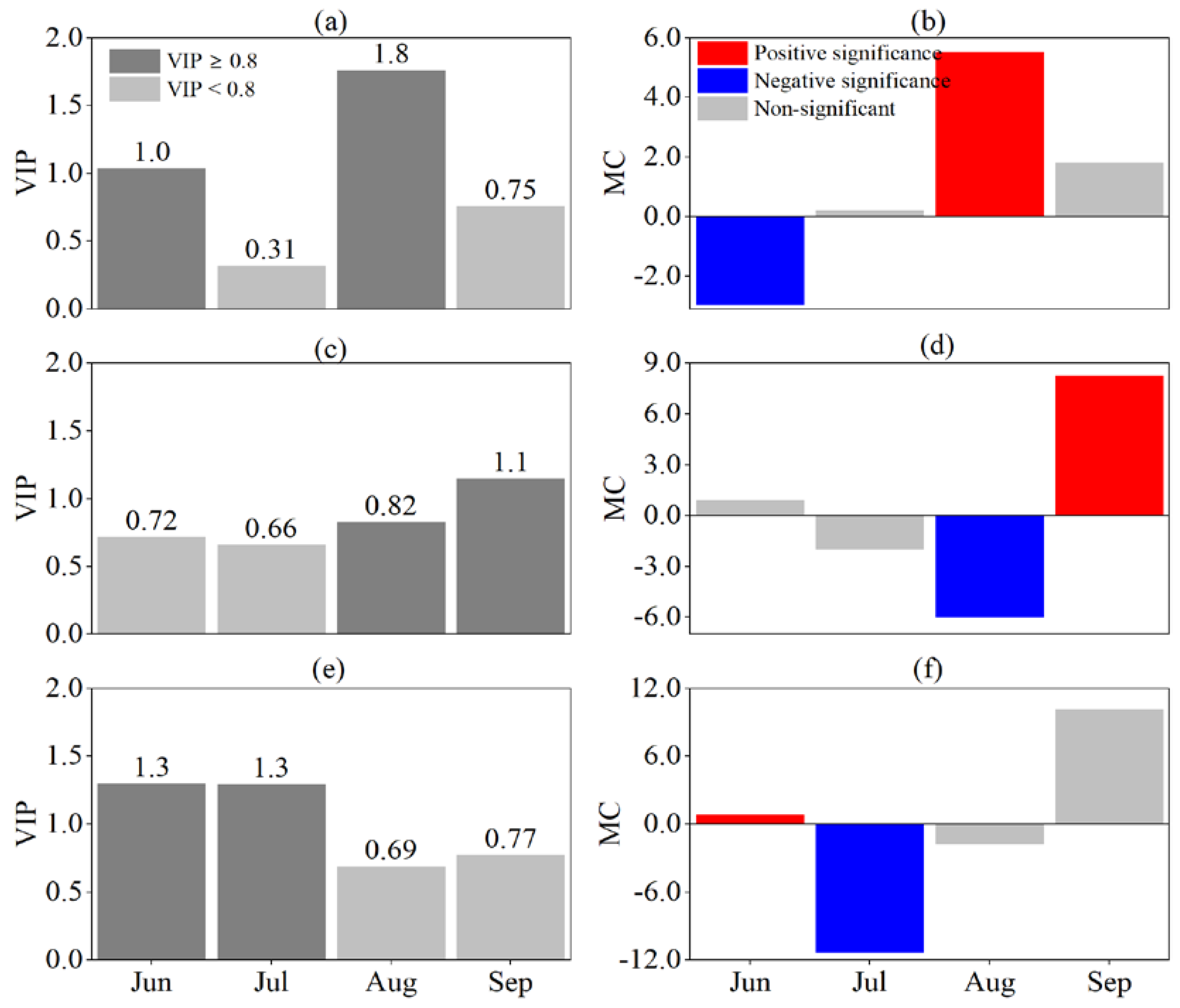
Disclaimer/Publisher’s Note: The statements, opinions and data contained in all publications are solely those of the individual author(s) and contributor(s) and not of MDPI and/or the editor(s). MDPI and/or the editor(s) disclaim responsibility for any injury to people or property resulting from any ideas, methods, instructions or products referred to in the content. |
© 2023 by the authors. Licensee MDPI, Basel, Switzerland. This article is an open access article distributed under the terms and conditions of the Creative Commons Attribution (CC BY) license (http://creativecommons.org/licenses/by/4.0/).




